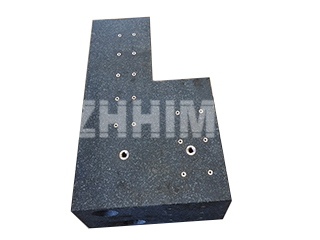In the world of ultra-precision manufacturing, the granite platform is the ultimate benchmark. Yet, many outside the industry assume that the flawless finish and sub-micron flatness achieved on these massive components are the result of purely automated, high-tech machining. The reality, as we practice it at ZHONGHUI Group (ZHHIMG®), is a sophisticated blend of industrial muscle and irreplaceable human craftsmanship.
Understanding the different finishing processes—and knowing when to apply them—is critical to meeting the rigorous precision requirements of sectors like semiconductor lithography, high-end metrology, and advanced aerospace assembly.
The Multi-Stage Journey to Precision
The manufacturing of a granite precision platform is not a single process; it’s a carefully choreographed sequence of material removal stages. Each stage is designed to systematically reduce geometric error and surface roughness while mitigating the material’s internal stress.
The journey begins after the raw granite slab has been cut to approximate size. This initial phase relies on heavy-duty machinery to remove the bulk of the material. We use large gantry or gantry-style CNC machines with diamond-impregnated grinding wheels to flatten the material to a coarse tolerance. This is a critical step for efficient material removal and establishing the initial geometry. Crucially, the process is always performed wet. This minimizes the heat generated by friction, preventing thermal distortion that could introduce internal stresses and compromise the component’s long-term stability.
Hand Lapping: The Final Frontier of Flatness
Once the mechanized process has taken the surface as far as it can go, the pursuit of micron and sub-micron accuracy begins. This is where human expertise remains entirely non-negotiable for top-grade platforms.
This final stage, known as lapping, utilizes a free abrasive slurry—not a fixed grinding wheel. The component is worked against a large, flat reference plate, causing the abrasive particles to roll and slide, removing minute amounts of material. This achieves a superior level of smoothness and geometric consistency.
Our veteran technicians, many with over three decades of specialized experience, perform this work. They are the human element that closes the manufacturing loop. Unlike CNC grinding, which is essentially a static reproduction of the machine’s accuracy, hand lapping is a dynamic, closed-loop process. Our craftsmen constantly stop to inspect the work using laser interferometers and electronic levels. Based on this real-time data, they perform hyper-localized adjustments, grinding only the high spots with precise, light pressure. This ability to continuously correct and refine the surface is what delivers the world-class tolerances required for DIN 876 Grade 00 or higher.
Furthermore, manual lapping uses lower pressure and less heat, allowing the natural geological stress within the granite to naturally release without introducing new mechanical stresses. This ensures the platform maintains its precision for decades.
Choosing the Right Method for Your Customization
When commissioning a custom granite component—such as a precision base for a Coordinate Measuring Machine (CMM) or an air-bearing stage—selecting the right finishing method is paramount and depends directly on the required tolerance.
For standard needs or rough layout applications, CNC surface grinding is usually sufficient. However, for applications demanding micron-level stability (like a standard inspection surface plate) we move to semi-fine grinding followed by light manual lapping.
For ultra-precision applications—such as semiconductor lithography platforms and CMM master bases—the cost and time investment in multi-step hand lapping is completely justified. It’s the only method capable of ensuring Repeat Reading Accuracy (the true test of uniformity across the surface) at the sub-micron level.
At ZHHIMG®, we engineer the process to meet your specifications. If your application demands a reference plane that resists environmental drift and performs flawlessly under high-dynamic loads, the blend of heavy machine work and dedicated human craftsmanship is the only viable choice. We integrate the grinding process directly into our stringent ISO-certified quality management system to ensure traceability and absolute authority in the final product.
Post time: Oct-17-2025

